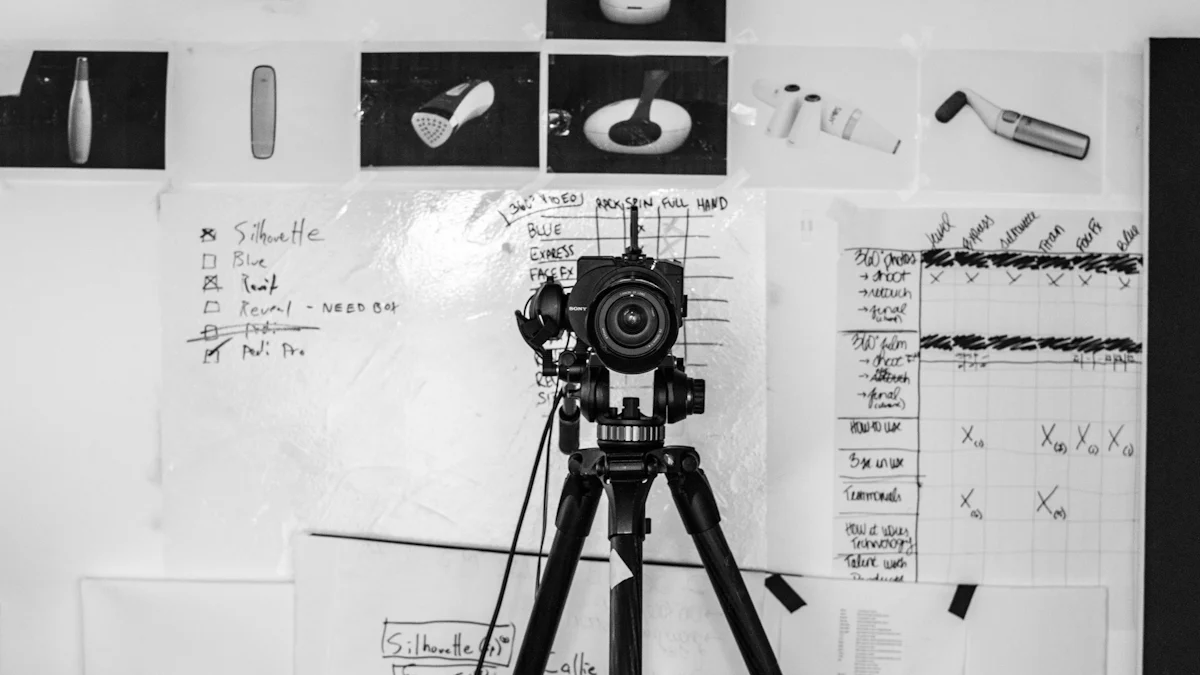Film Production
Guerrilla Filmmaking Techniques: How to Produce a Movie on a Shoestring Budget
By
Alex Darke
July 23, 2024 10:01 pm
Guerrilla filmmaking techniques involve producing films with ultra-low budgets, small crews, and minimal props. This method has become popular for its cost-effectiveness. Filmmakers such as Kevin Smith and Robert Rodriguez have demonstrated that working within budget constraints can inspire creative storytelling. The affordability of this filmmaking approach enables a wider range of storytellers to share their narratives without financial obstacles. Nevertheless, guerrilla filmmaking techniques come with challenges like scarce resources and strict timelines. Successfully navigating these hurdles demands resourcefulness and perseverance.
Guerrilla Filmmaking Techniques: Pre-Production Planning

Image Source: unsplash
Scriptwriting on a Budget
Writing for Available Resources
Writing a script with limited resources in mind can save time and money. Think about what you already have access to. For example, if you have a friend with a unique house, set a scene there. Kevin Smith used his workplace, a convenience store, as the main location for his film Clerks. This approach keeps costs down and adds authenticity to your story.
Collaborating with Writers and Actors
Collaborating with others can bring fresh ideas and reduce workload. Find writers and actors who share your passion. Offer them a share of future profits or other non-monetary benefits. Robert Rodriguez involved friends and family in his film El Mariachi. This not only saved money but also created a supportive team environment.
Budgeting and Fundraising
Crowdfunding Strategies
Crowdfunding platforms like Kickstarter and Indiegogo can help raise funds. Create a compelling pitch video that explains your project. Offer rewards like behind-the-scenes access or exclusive merchandise. Engage with your backers regularly to keep them excited about your film.
Securing In-Kind Donations
In-kind donations can significantly cut costs. Local businesses might offer free meals or locations in exchange for credits in your film. Approach companies and explain how their support will benefit them. Many guerrilla filmmakers have successfully secured costumes, props, and even equipment through this method.
Location Scouting
Finding Free or Low-Cost Locations
Public spaces often serve as excellent filming locations. Parks, streets, and community centers can provide diverse backdrops. Always scout these locations at different times to understand lighting and crowd patterns. Some of the most iconic scenes in guerrilla films were shot in public places without any cost.
Securing Permits and Permissions
Securing permits can sometimes be necessary, even for guerrilla filmmaking. Contact local authorities to understand the requirements. Sometimes, a simple conversation can grant you permission to film. Always have a backup plan in case you face any issues on the day of the shoot.
Guerrilla Filmmaking Techniques: Production Techniques

Image Source: unsplash
Minimalist Equipment
Essential Gear for Guerrilla Filmmaking
Guerrilla filmmaking techniques often require minimal gear. A good camera, a few lenses, and a microphone can suffice. Many filmmakers use DSLR or mirrorless cameras due to their portability and quality. A sturdy tripod helps stabilize shots, though some prefer handheld for a raw look. Lighting equipment like LED panels or even household lamps can work wonders. Always keep extra batteries and memory cards handy.
Renting vs. Buying Equipment
Renting equipment can save money, especially for short projects. Many rental houses offer affordable rates for guerrilla filmmakers. Buying gear makes sense for long-term use. Weigh the pros and cons based on your project needs. Renting allows access to high-end equipment without a huge investment. Buying provides the freedom to shoot whenever needed.
Small Crew Management
Roles and Responsibilities
A small crew means everyone wears multiple hats. Assign clear roles to avoid confusion. The director often handles multiple tasks like cinematography or sound. The producer might manage logistics and catering. Clear communication ensures everyone knows their responsibilities. Flexibility remains key in guerrilla filmmaking techniques.
Effective Communication
Effective communication keeps the crew on the same page. Daily briefings help outline the day's goals. Use walkie-talkies or group chats for instant updates. Encourage open dialogue to address issues quickly. A cohesive team works more efficiently, crucial for guerrilla filmmaking techniques.
Shooting on a Tight Schedule
Planning Efficient Shoot Days
Efficient shoot days require meticulous planning. Create a shot list and stick to it. Prioritize scenes with complex setups early in the day. Schedule breaks to keep the crew energized. Always have a backup plan for unforeseen issues. Adaptability proves essential in guerrilla filmmaking techniques.
Maximizing Limited Time
Maximizing limited time involves quick decision-making. Capture multiple takes from different angles to save time in editing. Use natural light to avoid lengthy lighting setups. Keep the crew small to move swiftly between locations. Flexibility and preparation ensure you make the most of every minute.
Expert Testimony:
"It’s simply impossible to tell what places may or may not be safe to film in, how long locations are available for, who may stop a production, etc. Adaptability is a must while shooting, and heavy preparation and research must be done to ensure you know as much as you possibly can."
Guerrilla Filmmaking Techniques: Post-Production Strategies
Cost-Effective Editing
Free and Low-Cost Editing Software
Editing software can get expensive, but plenty of free or low-cost options exist. DaVinci Resolve offers a robust free version with standard editing, effects, motion graphics, color correction, and audio editing. Many YouTubers and gamers use it because it provides many features without pro-level complexities. PowerDirector also stands out with built-in tools, advanced editing capabilities, and free tutorials, making it an excellent choice for budget-conscious filmmakers.
DIY Editing Tips
DIY editing can save money and add a personal touch to your film. Start by organizing all your footage. Label each clip clearly to avoid confusion. Use simple cuts and transitions to keep the story flowing smoothly. Experiment with color correction to enhance the visual appeal. Online tutorials can teach you new techniques. Practice makes perfect, so keep refining your skills.
Sound and Music
Affordable Sound Recording Techniques
Good sound quality enhances any film. Use affordable microphones to capture clear audio. Lavalier mics work well for dialogue, while shotgun mics excel in capturing ambient sounds. Record in quiet locations to minimize background noise. Test your equipment before shooting to ensure everything works correctly. Always monitor audio levels during recording.
Using Royalty-Free Music
Music sets the tone for your film. Royalty-free music offers a cost-effective solution. Websites like Free Music Archive and Incompetech provide a wide range of tracks. Choose music that complements your scenes. Always check the licensing terms to ensure proper usage. Adding the right music can elevate your film's emotional impact.
Marketing and Distribution
Leveraging Social Media
Social media platforms offer powerful tools for marketing your film. Create accounts on Facebook, Instagram, and Twitter. Share behind-the-scenes content to engage your audience. Use hashtags to reach a broader audience. Collaborate with influencers to promote your film. Regular updates keep your followers excited and invested in your project.
Submitting to Film Festivals
Film festivals provide excellent opportunities for exposure. Research festivals that align with your film's genre and theme. Follow submission guidelines carefully. Create a compelling cover letter and synopsis. Festivals like Sundance and Tribeca often showcase guerrilla films. Acceptance into a festival can boost your film's credibility and reach.
Let's recap some key guerrilla filmmaking techniques. Start with scriptwriting that leverages available resources. Collaborate with passionate writers and actors. Use crowdfunding and in-kind donations to stretch your budget. Scout free or low-cost locations and secure necessary permits.
Don't let budget constraints stop you. Embrace creativity and resourcefulness. Joshua Caldwell once said, "With proper planning, a clear vision, and a willingness to embrace unconventional methods, even the smallest crew can create something extraordinary."
Final tips for aspiring filmmakers: Plan meticulously, communicate effectively, and stay adaptable. Remember, the journey of guerrilla filmmaking teaches valuable lessons in creativity and collaboration. Now, go out and make your movie!

About the Author
Alex Darke is an Emmy-winning filmmaker, founder of the production company Momentous and owner of Filmmaking Central.

Filmmaking Central is a cutting-edge e-learning company dedicated to empowering aspiring filmmakers and content creators worldwide. With a robust library of comprehensive courses, expert-led workshops, and interactive learning materials, Filmmaking Central provides students with unparalleled access to industry professionals and innovative tools. By fostering an online community of passionate learners and storytellers, the platform aims to inspire creativity, develop essential skills, and ultimately cultivate the next generation of visionary filmmakers.
CONTACT
📍Las Vegas, NV
☎️ +1 888 494 5107
📧 hello@filmmakingcentral.com
SOCIAL
A Momentous Company © Filmmaking Central, All Rights Reserved. Here's our cookie policy page with all sorts of fun stuff. You know, privacy policy, disclaimer, and terms kind of stuff. Go back to the homepage or check out our courses and subscribe to our YouTube channel. You can also see our anti-SPAM policy, DCMA notice, earnings disclaimer, and affiliate disclosure.
